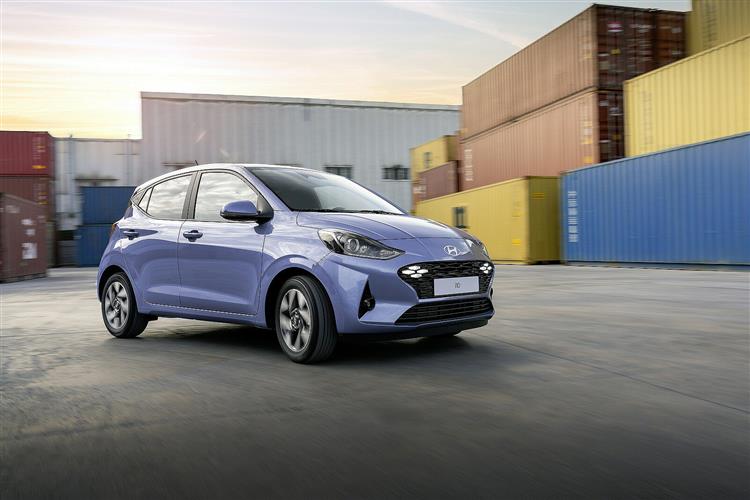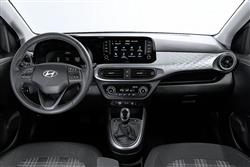i ON THE PRIZE (some text hidden) --NONE--
By Jonathan Crouch
Hyundai's quest for constant improvement means that it's set a high bar for itself with the third generation version of its smallest car, the i10. Jonathan Crouch drives the revised version.
Ten Second Reviewword count: 48
We're going to see far fewer citycars on the market in the coming years, which is welcome news for Hyundai, who has reaffirmed its commitment to the segment by introducing this third generation version of its popular i10 tiny hatch. It's billed as the most hi-tech citycar ever.
Backgroundword count: 181
Sometimes, the stars just align perfectly for a car manufacturer. Such was the case back in 2009 when two largely unrelated circumstances coincided. The introduction of the government's Scrappage Scheme saw a number of tired old cars being taken off our roads and resulted in a commensurate quantity of buyers with a modest sum of cash in their hands looking for something to buy. Fairly new onto the market and having just replaced the underwhelming Amica was the rather appealing Hyundai i10. Sales skyrocketed and for a short while, the i10 was the country's best selling car. It didn't last. While i10 sales continued quite strongly, the end of the Scrappage Scheme saw buyers return to their usual buying habits. Since then, Hyundai has tried hard to keep citycar buyers interested. It rejuvenated the i10 in second generation form in 2013, but it still didn't quite have the quality or the fashionable appeal of rivals like the Volkswagen up!, Skoda Citigo and SEAT Mii triplets. But this MK3 version, launched in 2019, has done better and here, has been usefully upgraded.
Driving Experienceword count: 288
Engine-wise, not much has changed, so as usual in an i10, there are two primary options, a three cylinder 1.0-litre 67PS Mpi unit and a four cylinder 1.2-litre 84PS 'Kappa' Mpi powerplant. Both engines can be had with either five-speed manual transmission or a (rather jerky) five-speed automated AMT auto gearbox. Both units offer decent pulling power by class standards - 96Nm in the 1.0-litre and 118Nm in the 1.2. Maximum speed in the 1.0-litre version is 97mph and the rest to 62mph sprint in the manual variant occupies 14.8s. There are a few things you want to tick off as soon as you get yourself seated behind the wheel of a good citycar. The first is visibility. If you're going to be jinking from lane to lane, you need great all-round sightlines. This i10 scores well in that regard, with good mirrors, windscreen pillars that aren't too obtrusive and a fairly high seat height. This MK3 model's reduced beltline at the front (11mm lower) and rear of the vehicle (13mm lower) provides drivers with a better view of the road on both sides, as well as a sleeker design. In combination with less C-pillar obscuration, now 11.9-degrees and down from 13.1-degrees, drivers have better visibility when performing parking manoeuvres. At the top of the range lies the flagship model, the i10 N Line. Here, you get the 1.0-litre Gdi three cylinder turbo engine from the larger i20 supermini, complete with 100PS and 172Nm of pulling power. If you don't mind paying supermini money for this top variant, you'll find that it'll deliver you quite as much spark as you'll need from a car of this kind. And, thank goodness, it only comes with the 5-speed manual gearbox.
To see the full road test text contact us on 0330 0020 227
Pictures (high res disabled)

.jpg)
|
.jpg)
|
.jpg)
| |||
.jpg)
|
.jpg)
|

|
Statistics (subset of data only)
Min |
Max |
|
Price: |
£16,030.00 (At 21 Oct 2024, 1.0 63PS Advance) |
£18,780.00 (At 21 Oct 2024, 1.2 79PS auto Premium) |
Insurance group 1-50: |
2 |
10 |
CO2 (g/km): |
116 (1.0 63PS) |
130 (1.2 auto) |
Max Speed (mph): |
96 |
109 |
0-62 mph (s): |
12.3 |
15.1 |
Combined Mpg: |
47.9 |
65.7 |
Length (mm): |
3665 |
|
Height (mm): |
1500 |
|
Weight (kg): |
933 |
961 |
... and 3 other stats available | ||
Scoring (subset of scores)
Category: Small Runabouts
| Performance | |
| Handling | |
| Comfort | |
| Space | |
| Styling, Build, Value, Equipment, Depreciation, Handling, Insurance and Total scores are available with our full data feed. | |



